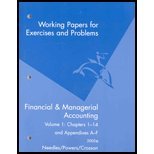Question
Question # 1 Toronto Company is considering two new machines that should produce considerable cost savings in its assembly operations. The cost of each machine
Question # 1
Toronto Company is considering two new machines that should produce considerable cost savings in its assembly operations. The cost of each machine is $20,000 and neither is expected to have a salvage value at the end of a 4-year useful life. The required rate of return of the company is 10% and the company prefers that a project return its initial outlay within the first half of the projects life. The annual after-tax cash savings for each machine are provided in the following table:
| Year | Annual After-tax Cash Savings | |
| Project A | Project B | |
| 1 | $2,000 | $10,000 |
| 2 | 4,000 | 8,000 |
| 3 | 8,000 | 4,000 |
| 4 | 10,000 | 2,000 |
| Salvage value-Year 4 | 6,000 | 6,000 |
| Total | 30,000 | 30,000 |
Present value factors @ 10%
| Year | 1 | 2 | 3 | 4 | 5 |
| PV factor | 0.909 | 0.826 | 0.751 | 0.683 | 0.621 |
Required:
1. Which project is more desirable strictly in terms of cash inflows? (1)
2. Which of the following is the correct Present value of cash inflows for Project A, assuming the company's required rate of return is 10%? (2)
A) $17,960
B) $22,058
C) $7000
D) None of the above
3. Which of the following is the correct Present value of cash inflows for Project B, assuming the company's required rate of return is 10%? (2)
A) $7225
B) $24,166
C) $7000
D) None of the above
4. Which of the following is the correct Net Present value of Project A, assuming the company's required rate of return is 10%? (1)
A) -$2040
B) $52
C) 2,058
D) None
5. Which of the following is the correct Net Present value of Project B, assuming the company's required rate of return is 10%? (1)
A) -4100
B) $68
C) 4,166
D) None
6. What is the maximum amount the company should be willing to pay for project A? (1)
A) -$100
B) $17,960
C) -$225
D) None of the above
7. What is the present value index for Project A? (1)
A) 1.10
B) .898
C) 1.25
D) 1.12
7. What is the present value index for Project A? (1)
A) 1.10
B) .898
C) 1.25
D) 1.12
8. What is the present value index for Project B? (1)
A) 1.0034
B) 1.21
C) 1.40
D) 1.25
9. Which project is better on the basis of present value index? (1)
A) Project A
B) Project B
C) Both are same
D) Cannot be determined
10. Which project(s) should be accepted based on NPV? (1)
A) Project A
B) Project B
C) Both are same
D) Cannot be determined
11. What is the payback period for Project A?(1)
A) 4 years
B) 3.3 years
C) 2.67 years
D) 3 years
12. What is the payback period for Project B?(1)
A) 4 years
B) 3.3 years
C) 2.67 years
D) Cannot be determined
13. Which project is better on the basis of payback period? (1)
A) Project A
B) Project B
C) Both are same
D) Cannot be determined
Step by Step Solution
There are 3 Steps involved in it
Step: 1

Get Instant Access to Expert-Tailored Solutions
See step-by-step solutions with expert insights and AI powered tools for academic success
Step: 2

Step: 3

Ace Your Homework with AI
Get the answers you need in no time with our AI-driven, step-by-step assistance
Get Started


